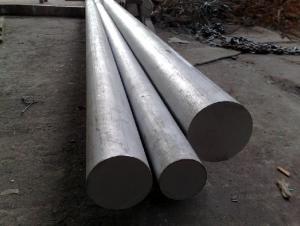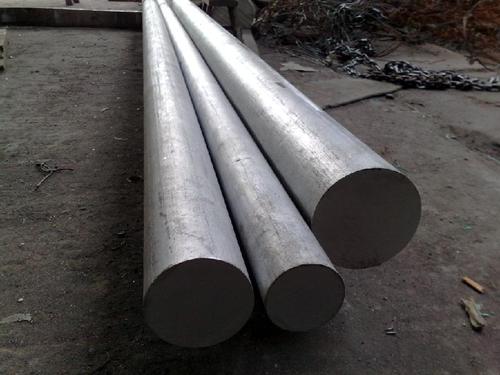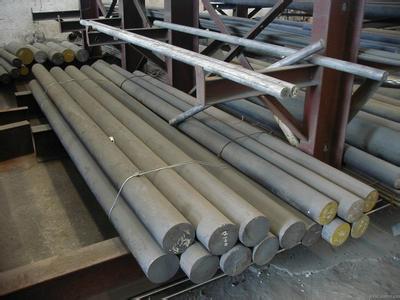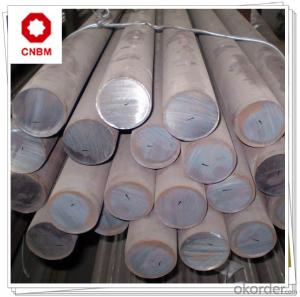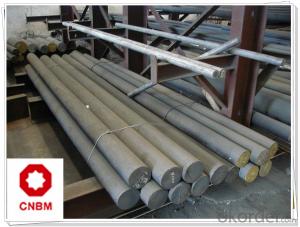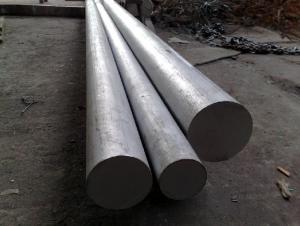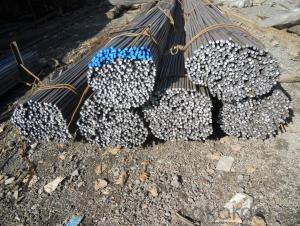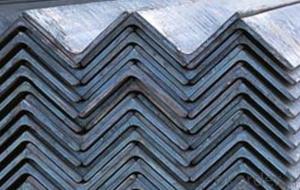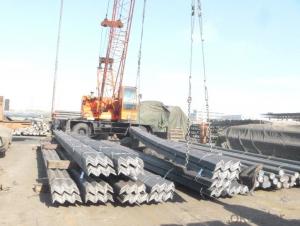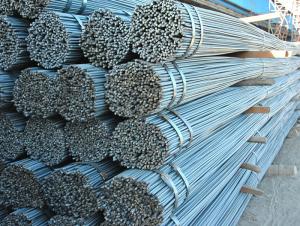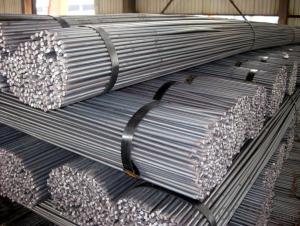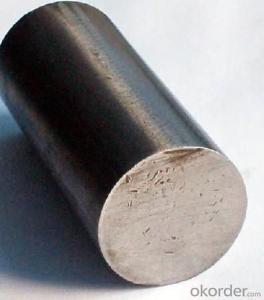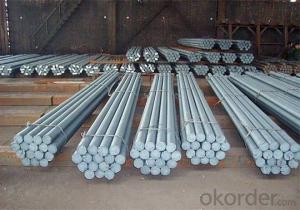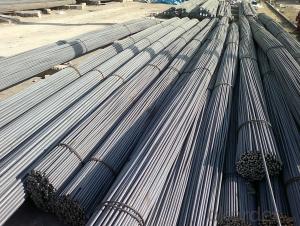High grade hot rolled round steel
- Loading Port:
- China Main Port
- Payment Terms:
- TT OR LC
- Min Order Qty:
- -
- Supply Capability:
- -
OKorder Service Pledge
OKorder Financial Service
You Might Also Like
Round steel refers to the solid section for circular strip steel. Its specifications expressed as a number of mm in diameter, such as "50" indicates that the diameter of 50 mm round steel.
The material of round steel, Q195, Q235, 10 #, 20 #, 35 #, 45 #, Q215, Q235, 304, 316, 40 cr, cr, 20 crmo, 35 crmo, 42 crmo, 40 crnimo, GCr15, 65 mn, 50 mn, cr, 3 cr2w8v, 20 crmnti, 5 crmnmo, etc.
Round steel hot rolling, forging and cold drawn three kinds. The specifications of the hot rolled round steel of 5.5 to 250 mm. Among them: 5.5-25 mm small round steel are mostly with straight bundles of supplies, commonly used for reinforcing steel bar, bolt, and various mechanical parts; More than 25 mm round steel, mainly used in the manufacture of machinery parts and seamless steel tube. The difference between the round steel and other steel: 1 appearance is not the same, round steel exterior circle of light, no lines without ribs, and other steel surface appearance has a groove or a rib, thus causing the cohesive force of small round steel and concrete, and the other the cohesive force of steel bar and reinforced concrete. 2 ingredients are different, round steel (level 1) steel belong to the normal low carbon steel, more than other reinforcement for alloy steel. Three different intensity, low intensity of round steel and other steel with high intensity, the diameter of the same size of round steel compared with other steel bar, round steel can withstand strength than other bar is small, but the plastic is better than other steel round steel, the round steel before is pulled with large deformation, and other steel before be pulled deformation is much smaller.
classification
The editor
1. According to the chemical classification
Carbon steel according to the chemical composition (i.e., with carbon content) can be divided into low carbon steel, medium carbon steel and high carbon steel.
(1) low carbon steel
Also known as mild steel, carbon content from 0.10% to 0.30% of low carbon steel is easy to accept all kinds of processing such as forging, welding and cutting, often used in the production chain, rivet, bolts, shaft, etc.
(2) the medium carbon steel
Carbon is 0.25% ~ 0.60% of the carbon steel. Have a calming, half killed steel, steel and other steel products. In addition to the carbon can also contain a small amount of manganese (0.70% ~ 1.20%). According to the quality of the products are divided into ordinary carbon structural steel and high quality carbon structural steel. Hot working and cutting performance is good, poor welding performance. Strength and hardness is higher than low carbon steel and the plasticity and toughness lower than that of low carbon steel. Without heat treatment, direct use of hot rolled, cold drawn material, can be used after heat treatment. The medium carbon steel after quenching and tempering has good comprehensive mechanical properties. To achieve the highest hardness about HRC55 (HB538), sigma b for 600 ~ 600 mpa. So in a moderate level of a variety of purposes, medium carbon steel is the most widely used, except as building materials, also used in the manufacture of various kinds of machinery parts.
(3) the high carbon steel
Often called tool steel, carbon content from 0.60% to 1.70%, can be hardening and tempering. Hammer, crowbar, etc by the carbon content of 0.75% steel manufacturing; Cutting tools such as drill, tap, reamer, etc by between 0.90% and 1.00% of the carbon content of steel manufacturing.
2. According to the quality of the steel
According to the quality of the steel can be divided into ordinary carbon steel and high quality carbon steel.
(1) ordinary carbon structural steel, also known as ordinary carbon steel, the carbon content, performance range, and phosphorus, sulfur and other residual elements content is relatively wide. In China and some countries according to the guarantee of delivery condition is divided into three categories: class A steel steel (class A) is to ensure that the mechanical properties of steel. B steel steel (class B) is the guarantee of the chemical composition of the steel. Special type of steel (class C) steel is both ensure the mechanical properties and guarantee the chemical composition of steel, often used in the manufacture of the important structures. China is now the production and use of the most is around 0.20% of A3 carbon steel (steel) a class 3, mainly used in engineering structure.
Some carbon structural steel and adding trace amounts of aluminum or niobium (or other) carbide forming elements to form nitrides or carbide particles, to limit the grain growth, make the steel reinforcement, save steel. In China and some countries, in order to adapt to the special requirements of professional steel, the chemical composition and properties of ordinary carbon structural steel, so as to develop a series of ordinary carbon structural steel major steel, such as Bridges, buildings, pressure vessel steel, steel, etc.).
(2) high quality carbon structural steel and ordinary carbon structural steel, sulfur, phosphorus and other non-metallic inclusion content is low. According to carbon content and purpose is different, this kind of steel is roughly divided into three categories: (1) is less than 0.25% C for low carbon steel, notably the carbon less than 0.10% of the 08 f, 08 al and so on, because has the very good deep-drawing property and weldability and is widely used for deep drawing parts such as automobile, can... And so on. The main material of 20 g is making ordinary boiler. In addition, low carbon steel as carburizing steel, widely used in mechanical manufacturing industry. (2) 0.25 ~ 0.60% C for medium carbon steel, used in the quenched and tempered state more, make parts of machinery manufacturing industry. (3) greater than 0.6% C for high carbon steel, used in the manufacture of springs, gears, roll, etc. According to different manganese content, and can be divided into ordinary manganese content (0.25 ~ 0.8%) and high manganese content (0.7 ~ 1.0% and 0.9 ~ 1.2%) steel group. Manganese can improve the hardenability of steel, strengthen the ferrite, improve the steel yield strength, tensile strength and abrasion resistance. Usually in the high manganese steel grades after additional tags "Mn", such as 15 Mn, 20 Mn to distinguish it from normal carbon steel containing manganese content.
3. According to the classification purpose
According to the purposes and can be divided into carbon structural steel, carbon tool steel.
Carbon tool steel carbon content between 0.65 ~ 1.35%, high hardness and high wear resistance can be obtained after heat treatment, mainly used in the manufacture of various tools and cutters, mould and measuring tool (see tool steel).
Carbon structural steel in accordance with the steel yield strength is divided into five grades:
Q195, Q215, Q235, Q255, Q275
Each brand due to different quality is divided into A, B, C, D level, there are four most, some only one; In addition, a steel smelting deoxidizing method.
Deoxidizing method symbols:
F - rimmed steel
B - half killed steel
Z - killed steel
TZ - special killed steel
- Q: Can steel round bars be used for making steering linkages?
- Yes, steel round bars can be used for making steering linkages. Steel round bars are commonly used in various mechanical applications due to their strength and durability. They offer the necessary stability and rigidity required for steering linkages, making them a suitable choice for this purpose.
- Q: Are steel round bars suitable for use in the manufacturing of fittings?
- Yes, steel round bars are suitable for use in the manufacturing of fittings. Steel round bars offer several advantages that make them a preferred choice for fittings manufacturing. Firstly, steel is known for its excellent strength and durability, making it ideal for creating reliable and long-lasting fittings. Steel round bars are capable of withstanding heavy loads and high pressure, ensuring that the fittings can perform effectively in various applications. Additionally, steel round bars are highly versatile and can be easily shaped and formed into different fittings designs. This flexibility allows manufacturers to create fittings that meet specific requirements and dimensions, ensuring a perfect fit for various systems and structures. Moreover, steel is resistant to corrosion, which is essential for fittings that may come into contact with moisture or other corrosive substances. The anti-corrosion properties of steel ensure that fittings maintain their integrity and functionality over time, even in harsh environments. Furthermore, steel round bars are readily available in a wide range of sizes, grades, and finishes, providing manufacturers with ample options to meet different specifications and design preferences. In conclusion, steel round bars are a suitable choice for use in the manufacturing of fittings due to their strength, durability, versatility, corrosion resistance, and availability. These attributes make steel round bars a reliable and efficient material for creating high-quality fittings that can withstand various operating conditions and provide long-lasting performance.
- Q: What are the different tolerances for steel round bars?
- The different tolerances for steel round bars depend on various factors such as the diameter, length, and intended application. Common tolerances for steel round bars include diameter tolerances ranging from +/- 0.005 inches to +/- 0.030 inches, length tolerances ranging from +/- 0.125 inches to +/- 0.500 inches, and straightness tolerances ranging from 0.0125 inches per foot to 0.030 inches per foot. However, specific tolerances may vary depending on the specific requirements set by the industry or customer.
- Q: What is the average cost of steel round bars?
- The average cost of steel round bars can vary depending on various factors such as size, grade, quantity, and market conditions. It is recommended to check with steel suppliers or conduct market research to get an accurate and up-to-date average cost.
- Q: Can steel round bars be hardened or tempered?
- Steel round bars have the capability to be hardened or tempered. To harden them, the steel is heated to a specific temperature and then rapidly cooled, often by quenching it in water or oil. This treatment boosts the steel's hardness and strength, making it more resistant to wear and deformation. On the other hand, tempering involves reheating the hardened steel to a lower temperature and then cooling it gradually. This process decreases the steel's brittleness and enhances its toughness and ductility. Both hardening and tempering can be applied to steel round bars to achieve desired mechanical properties for different applications.
- Q: How do you prevent warping during welding of steel round bars?
- To prevent warping when welding steel round bars, there are several precautions that can be taken: 1. Ensure proper fit-up: Before welding, make sure the round bars are correctly aligned and fitted together. Any gaps or misalignments can cause uneven heating and cooling, increasing the likelihood of warping. 2. Divide welding into smaller sections: Instead of continuously welding along the entire length of the round bar, break it down into multiple smaller sections. This will help distribute heat more evenly and decrease the risk of warping. 3. Use low heat input techniques: Employ welding techniques like pulse welding or tack welding that minimize heat input. These methods allow for controlled and intermittent heating, reducing the chances of warping. 4. Consider preheating: Preheating the round bars before welding can also prevent warping, especially with thicker bars or when welding dissimilar metals. Preheating helps minimize the temperature difference between the weld and the surrounding material, reducing the risk of warping. 5. Monitor and control heat input: Keep a close eye on the heat input during welding. Excessive heat can cause rapid expansion and contraction, leading to warping. Use appropriate welding parameters, such as lower amperage and shorter welding times, to control the heat input. 6. Utilize welding fixtures: Use welding fixtures or jigs to securely hold the round bars in place during welding. This helps maintain proper alignment and prevents movement, reducing the chance of warping. 7. Allow for natural cooling: After welding, let the round bars cool down slowly and naturally. Avoid rapid cooling methods like quenching, as they can induce stress and increase the risk of warping. By implementing these measures, the likelihood of warping when welding steel round bars can be significantly reduced, resulting in higher quality and more dependable welded joints.
- Q: What are the different types of steel round bar surface finishes used in the marine industry?
- In the marine industry, various surface finishes are commonly utilized for steel round bars. These finishes possess distinct characteristics and serve specific purposes, making them suitable for particular applications. The marine industry frequently employs the following steel round bar surface finishes: 1. Polished Finish: To achieve a polished finish, the surface of the steel round bar is ground until it becomes smooth and reflective. This finish is employed when aesthetics are important, as it provides an appealing and shiny appearance. Polished finishes are commonly used for decorative purposes on boat fittings, handrails, and other exposed areas. 2. Mill Finish: Mill finish refers to the surface condition of steel round bars when they are received from the mill without any additional treatment. This finish is characterized by a rough and dull appearance, as it is not intended to be visually pleasing. Mill finishes are typically utilized when a smooth or polished surface is unnecessary, such as in structural applications or when the material will be painted or coated. 3. Shot Blasted Finish: Shot blasting is a surface treatment process that involves propelling small steel shots at high velocity onto the surface of the round bar. This process eliminates surface impurities, scales, or rust, resulting in a clean and slightly textured finish. Shot blasted finishes are commonly used in marine applications where improved adhesion of coatings or paint is required, as the textured surface provides a better bonding surface. 4. Hot Rolled Finish: The hot rolled finish is attained by subjecting the steel round bar to high temperatures during the manufacturing process, followed by rapid cooling. This process creates a scaly surface with a rough texture. Hot rolled finishes are suitable for marine applications where corrosion resistance is not the primary concern and where the material will undergo further processing or coating. 5. Galvanized Finish: Galvanizing involves applying a protective zinc coating to the surface of the steel round bar. This finish offers excellent corrosion resistance, making it ideal for marine applications where the material will be exposed to saltwater or harsh environmental conditions. Galvanized finishes are commonly employed for boat trailers, marine hardware, and other components that require enhanced protection against corrosion. These are merely a few examples of the diverse steel round bar surface finishes used in the marine industry. Each finish possesses its own unique properties and advantages, allowing for a wide range of applications in the maritime sector. The choice of finish depends on factors such as aesthetics, corrosion resistance, coating compatibility, and the specific requirements of the marine application.
- Q: Can steel round bars be used in the production of musical instruments?
- Certainly! Musical instruments can indeed be produced using steel round bars. Steel, being a versatile material, possesses a wide array of desirable attributes including strength, durability, and resonance. Although wood is typically the go-to material for crafting musical instruments, steel can be utilized in specific instances to augment the instrument's sound and performance. For instance, steel round bars can be implemented in the fabrication of various components such as keys or valves for wind instruments like saxophones or trumpets. Moreover, these bars can be employed to construct the internal support systems in instruments like guitars or cellos, thereby providing stability and enriching tonal qualities. Furthermore, steel round bars can be employed in the construction of percussion instruments such as steel drums or xylophones, where their robust and resonant attributes are highly sought after. On the whole, although wood remains the more prevalent choice in the realm of musical instrument production, steel can certainly be employed in specific scenarios to attain desired sound characteristics and structural integrity.
- Q: Can steel round bars be used as axles or shafts?
- Axles or shafts can indeed be made from steel round bars. This is because steel possesses excellent strength and durability, making it a popular choice for axles and shafts. In particular, steel round bars are ideal for applications that involve rotational movement, such as axles and shafts, as they can handle heavy loads and endure bending and torsional forces. Moreover, steel round bars can be machined and heat-treated to meet specific requirements for hardness and surface finish, further enhancing their suitability for use as axles or shafts. All in all, steel round bars are a dependable and widely utilized option for axles and shafts in various industries, including automotive, machinery, and construction.
- Q: Can steel round bars be used in the production of springs?
- Certainly! Springs can be produced using steel round bars. Steel is a commonly chosen material for manufacturing springs because it possesses strong attributes and excellent durability. Steel round bars are frequently employed as the foundation material for springs because they can be easily manipulated and formed into the desired spring shape. Moreover, by subjecting steel round bars to heat treatment, their mechanical properties can be improved, rendering them appropriate for a range of spring applications. The selection of steel type relies on the desired characteristics and requirements of the spring, such as the desired level of flexibility and resistance to deformation. In summary, steel round bars are extensively employed in spring production due to their outstanding mechanical properties, making them a suitable option for a variety of spring applications.
Send your message to us
High grade hot rolled round steel
- Loading Port:
- China Main Port
- Payment Terms:
- TT OR LC
- Min Order Qty:
- -
- Supply Capability:
- -
OKorder Service Pledge
OKorder Financial Service
Similar products
Hot products
Hot Searches
Related keywords
